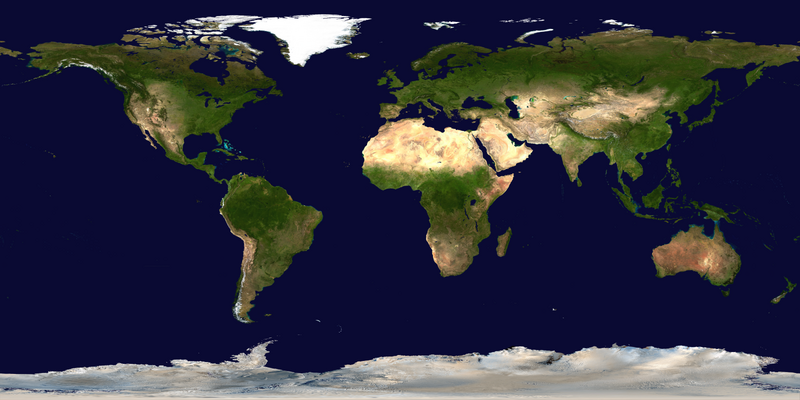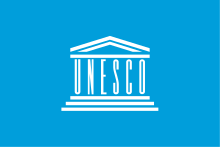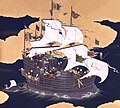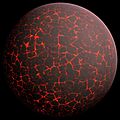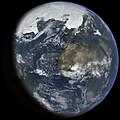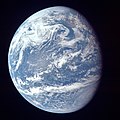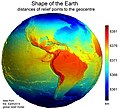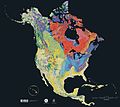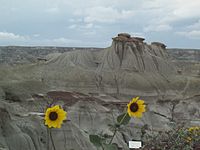Portal:World
The World Portal

The world is the totality of entities, the whole of reality, or everything that exists. The nature of the world has been conceptualized differently in different fields. Some conceptions see the world as unique while others talk of a "plurality of worlds". Some treat the world as one simple object while others analyze the world as a complex made up of parts.
In scientific cosmology, the world or universe is commonly defined as "[t]he totality of all space and time; all that is, has been, and will be". Theories of modality talk of possible worlds as complete and consistent ways how things could have been. Phenomenology, starting from the horizon of co-given objects present in the periphery of every experience, defines the world as the biggest horizon or the "horizon of all horizons". In philosophy of mind, the world is contrasted with the mind as that which is represented by the mind. Theology conceptualizes the world in relation to God, for example, as God's creation, as identical to God or as the two being interdependent. In religions, there is a tendency to downgrade the material or sensory world in favor of a spiritual world to be sought through religious practice. A comprehensive representation of the world and our place in it, as is found in religions, is known as a worldview. Cosmogony is the field that studies the origin or creation of the world while eschatology refers to the science or doctrine of the last things or of the end of the world.
In various contexts, the term "world" takes a more restricted meaning associated, for example, with the Earth and all life on it, with humanity as a whole or with an international or intercontinental scope. In this sense, world history refers to the history of humanity as a whole and world politics is the discipline of political science studying issues that transcend nations and continents. Other examples include terms such as "world religion", "world language", "world government", "world war", "world population", "world economy", or "world championship". (Full article...)
Selected articles -
General images -
Megacities of the world -
Manila (/məˈnɪlə/ mə-NIL-ə; Filipino: Maynila, pronounced [majˈnilaʔ]), officially the City of Manila (Filipino: Lungsod ng Maynila, [luŋˈsod nɐŋ majˈnilaʔ]), is the capital and second-most-populous city of the Philippines. Located on the eastern shore of Manila Bay on the island of Luzon, it is classified as a highly urbanized city. As of 2019, it is the world's most densely populated city proper. It was the first chartered city in the country, and was designated as such by the Philippine Commission Act No. 183 on July 31, 1901. It became autonomous with the passage of Republic Act No. 409, "The Revised Charter of the City of Manila", on June 18, 1949. Manila is considered to be part of the world's original set of global cities because its commercial networks were the first to extend across the Pacific Ocean and connect Asia with the Spanish Americas through the galleon trade; when this was accomplished, it was the first time an uninterrupted chain of trade routes circling the planet had been established.
By 1258, a Tagalog-fortified polity called Maynila existed on the site of modern Manila. On June 24, 1571, after the defeat of the polity's last indigenous Rajah Sulayman in the Battle of Bangkusay, Spanish conquistador Miguel López de Legazpi began constructing the walled fortification Intramuros on the ruins of an older settlement from whose name the Spanish-and-English name Manila derives. Manila was used as the capital of the captaincy general of the Spanish East Indies, which included the Marianas, Guam and other islands, and was controlled and administered for the Spanish crown by Mexico City in the Viceroyalty of New Spain. (Full article...)Did you know -

- ... that Earth 300 has designed a climate research vessel that would include a molten salt reactor and a quantum computer?
- ... that the first public usage of the term "ongoing Nakba" is widely credited to Hanan Ashrawi, who referenced it in a speech at the 2001 World Conference against Racism?
- ... that the 2015 video game Worlds of Magic, intended as a spiritual successor to the classic game Master of Magic, failed to impress most reviewers?
- ... that at the 1965 World Pentathlon Championships, Herbert Polzhuber was said to have drunk ten beers and a bottle of cognac before firing his pistol at the ground and passing out?
- ... that Dr. Disaster's office collapsed in an earthquake on this day in 2011?
- ... that author Ann Howard interviewed more than 100 Australians about their experiences as child evacuees sent inland during World War II when a Japanese invasion seemed imminent?
- ... that St. Bernward in Döhren was consecrated in 1893, when part of Christoph Hehl's design of a basilica in the Romanesque Revival style was built, but the building was only completed after World War II?
- ... that the World-Wide Navigational Warning Service divides the entire ocean into just 21 radio areas?
Countries of the world -

Sudan, officially the Republic of the Sudan, is a country in Northeast Africa. It borders the Central African Republic to the southwest, Chad to the west, Egypt to the north, Eritrea to the northeast, Ethiopia to the southeast, Libya to the northwest, South Sudan to the south, and the Red Sea. It has a population of 45.7 million people as of 2022 and occupies 1,886,068 square kilometres (728,215 square miles), making it Africa's third-largest country by area and the third-largest by area in the Arab League. It was the largest country by area in Africa and the Arab League until the secession of South Sudan in 2011; since then both titles have been held by Algeria. Its capital and most populous city is Khartoum.
The area that is now Sudan witnessed the Khormusan (c. 40000–16000 BC), Halfan culture (c. 20500–17000 BC), Sebilian (c. 13000 BC–10000 BC), Qadan culture (c. 15000–5000 BC), the war of Jebel Sahaba, the earliest known war in the world, around 11500 BC, A-Group culture (c. 3800 BC–3100 BC), Kingdom of Kerma (c. 2500–1500 BC), the Egyptian New Kingdom (c. 1500 BC–1070 BC), and the Kingdom of Kush (c. 785 BC–350 AD). After the fall of Kush, the Nubians formed the three Christian kingdoms of Nobatia, Makuria, and Alodia. Between the 14th and 15th centuries, most of Sudan was gradually settled by Arab nomads. From the 16th to the 19th centuries, central and eastern Sudan were dominated by the Funj sultanate, while Darfur ruled the west and the Ottomans the east. In 1811, Mamluks established a state at Dunqulah as a base for their slave trading. Under Turco-Egyptian rule of Sudan after the 1820s, the practice of trading slaves was entrenched along a north–south axis, with slave raids taking place in southern parts of the country and slaves being transported to Egypt and the Ottoman empire. From the 19th century, the entirety of Sudan was conquered by the Egyptians under the Muhammad Ali dynasty. Religious-nationalist fervour erupted in the Mahdist Uprising in which Mahdist forces were eventually defeated by a joint Egyptian-British military force. In 1899, under British pressure, Egypt agreed to share sovereignty over Sudan with the United Kingdom as a condominium. In effect, Sudan was governed as a British possession. The Egyptian revolution of 1952 toppled the monarchy and demanded the withdrawal of British forces from all of Egypt and Sudan. Muhammad Naguib, one of the two co-leaders of the revolution, and Egypt's first President, who was half-Sudanese and had been raised in Sudan, made securing Sudanese independence a priority of the revolutionary government. The following year, under Egyptian and Sudanese pressure, the British agreed to Egypt's demand for both governments to terminate their shared sovereignty over Sudan and to grant Sudan independence. On 1 January 1956, Sudan was duly declared an independent state. (Full article...)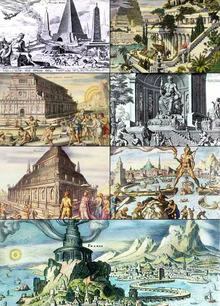
The Seven Wonders of the Ancient World, also known as the Seven Wonders of the World or simply the Seven Wonders, is a list of seven notable structures present during classical antiquity. The first known list of seven wonders dates back to the 2nd–1st century BC.
While the entries have varied over the centuries, the seven traditional wonders are the Great Pyramid of Giza, the Colossus of Rhodes, the Lighthouse of Alexandria, the Mausoleum at Halicarnassus, the Temple of Artemis, the Statue of Zeus at Olympia, and the Hanging Gardens of Babylon. Using modern-day countries, two of the wonders were located in Greece, two in Turkey, two in Egypt, and one in Iraq. Of the seven wonders, only the Pyramid of Giza, which is also by far the oldest of the wonders, still remains standing, while the others have been destroyed over the centuries. There is scholarly debate over the exact nature of the Hanging Gardens, and there is doubt as to whether they existed at all. (Full article...)Related portals

Protected areas of Brazil included various classes of area according to the National System of Nature Conservation Units (SNUC), a formal, unified system for federal, state and municipal parks created in 2000. (Full article...)
Selected world maps
World records
- List of Olympic records in athletics
- List of world records in athletics
- List of junior world records in athletics
- List of world records in masters athletics
- List of world youth bests in athletics
- List of IPC world records in athletics
- List of world records in canoeing
- List of world records in chess
- List of cycling records
- List of world records in track cycling
- List of world records in finswimming
- List of world records in juggling
- List of world records in rowing
- List of world records in speed skating
- List of world records in swimming
- List of IPC world records in swimming
- List of world records in Olympic weightlifting
Topics
Categories
Wikimedia
The following Wikimedia Foundation sister projects provide more on this subject:
-
Commons
Free media repository -
Wikibooks
Free textbooks and manuals -
Wikidata
Free knowledge base -
Wikinews
Free-content news -
Wikiquote
Collection of quotations -
Wikisource
Free-content library -
Wikispecies
Directory of species -
Wikiversity
Free learning tools -
Wikivoyage
Free travel guide -
Wiktionary
Dictionary and thesaurus

